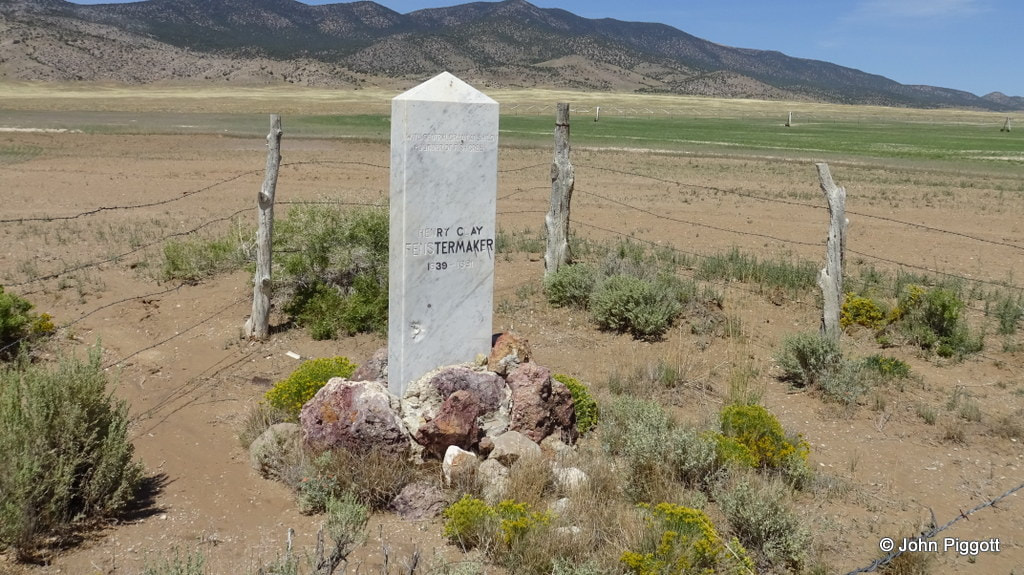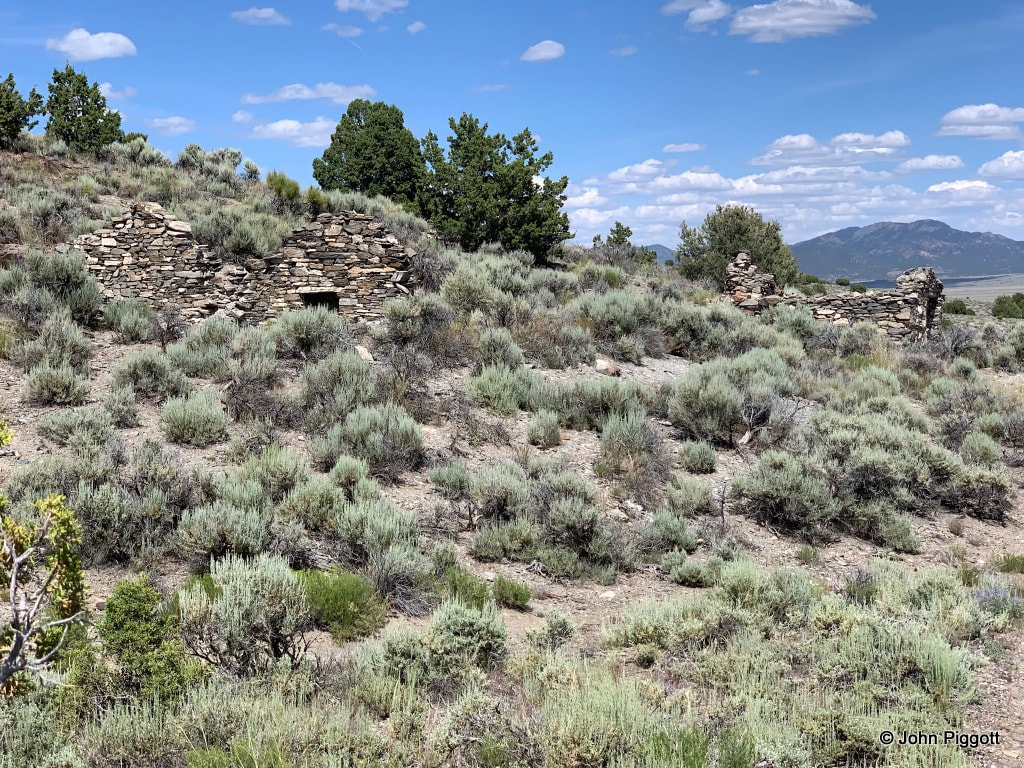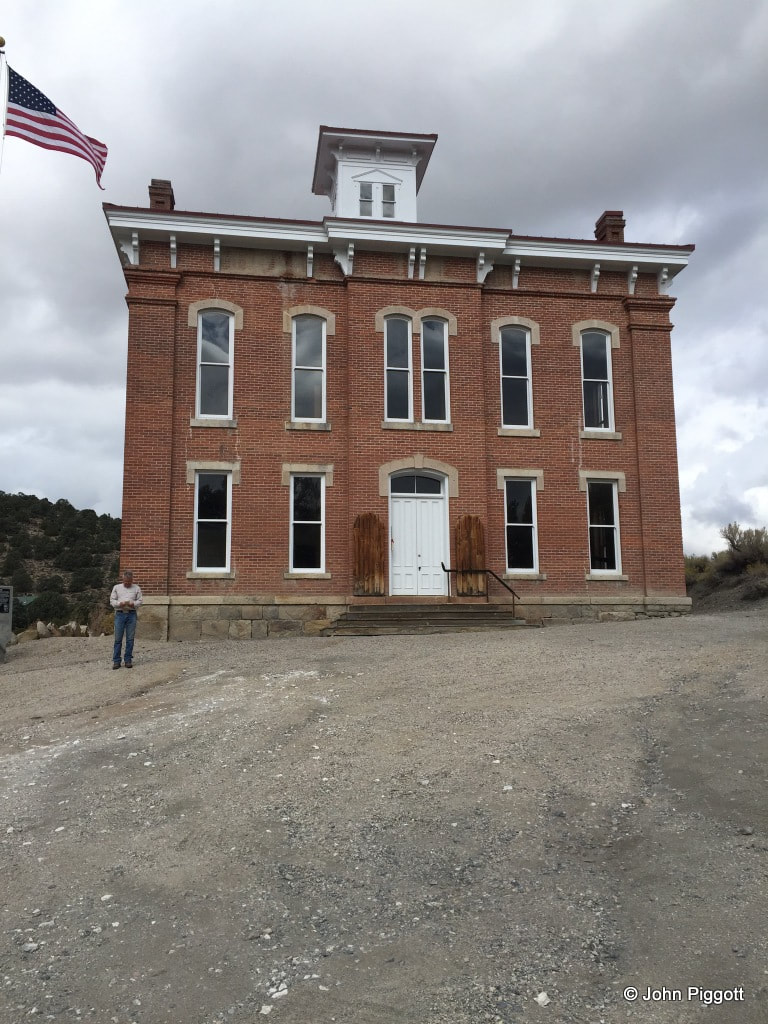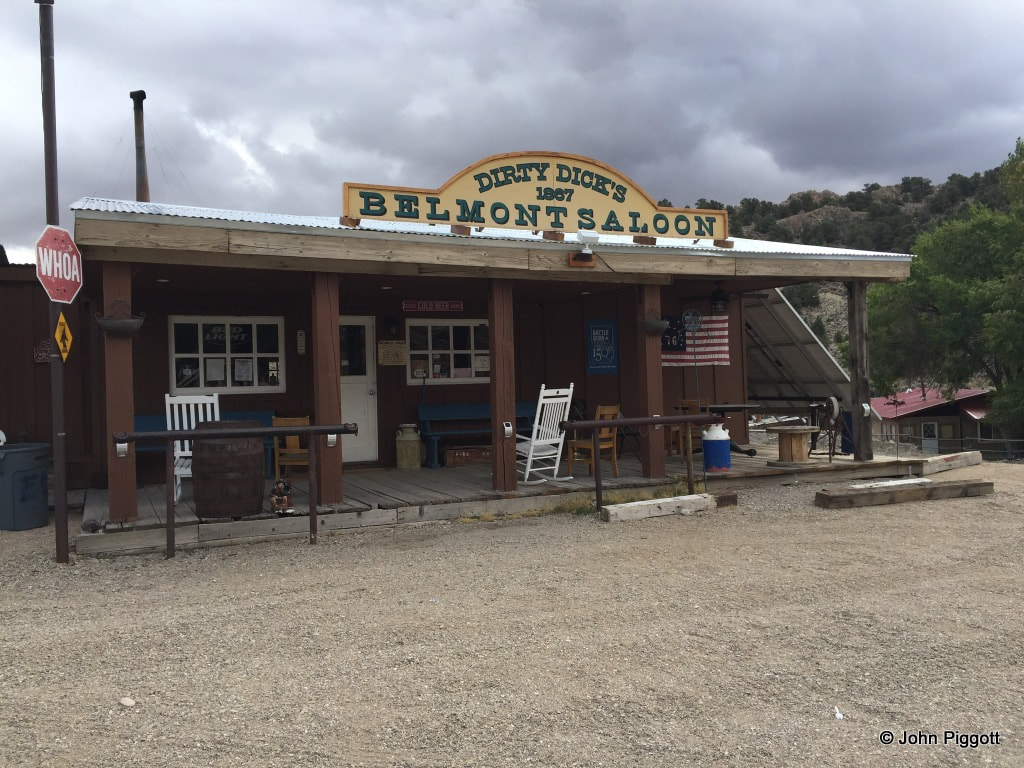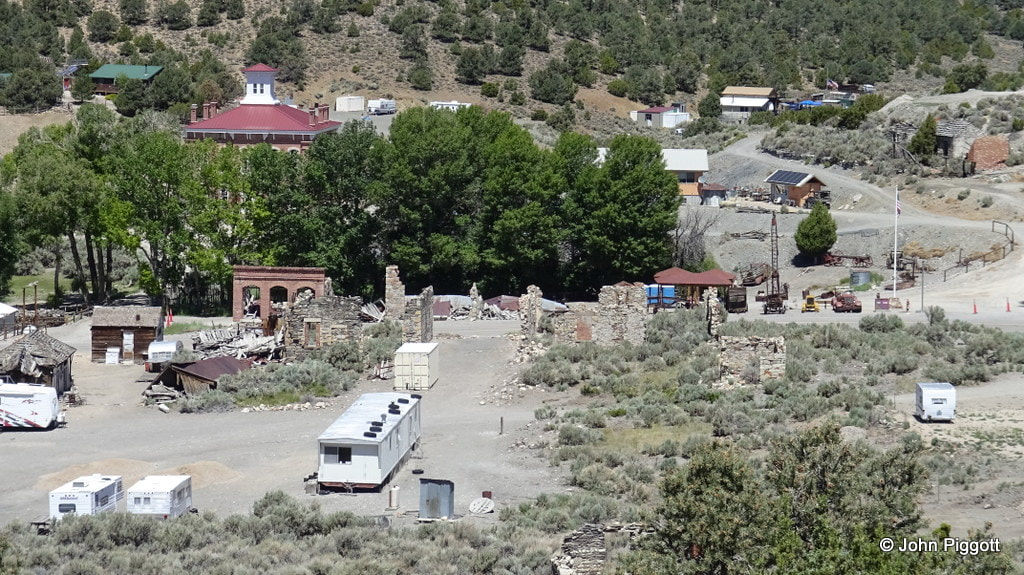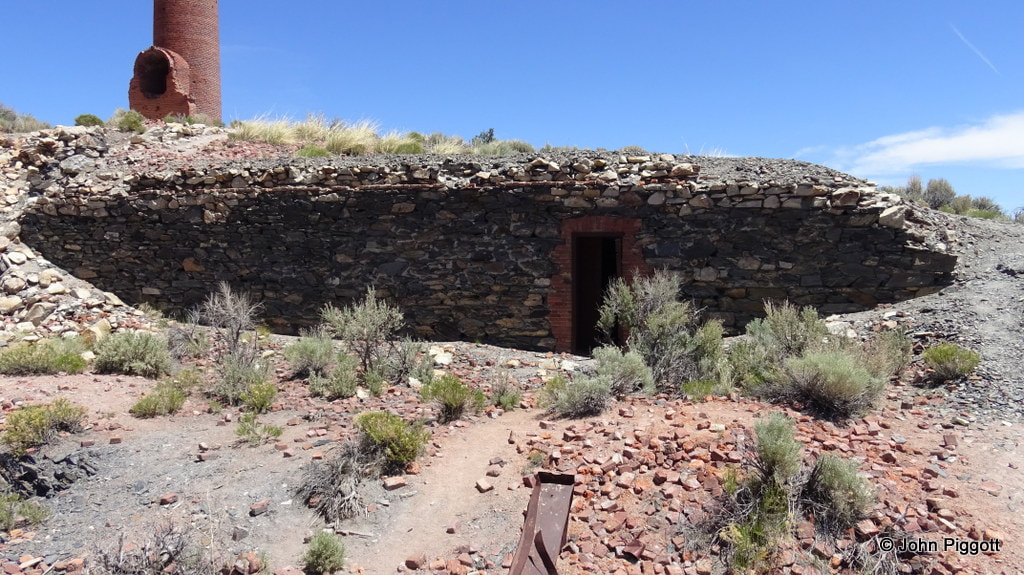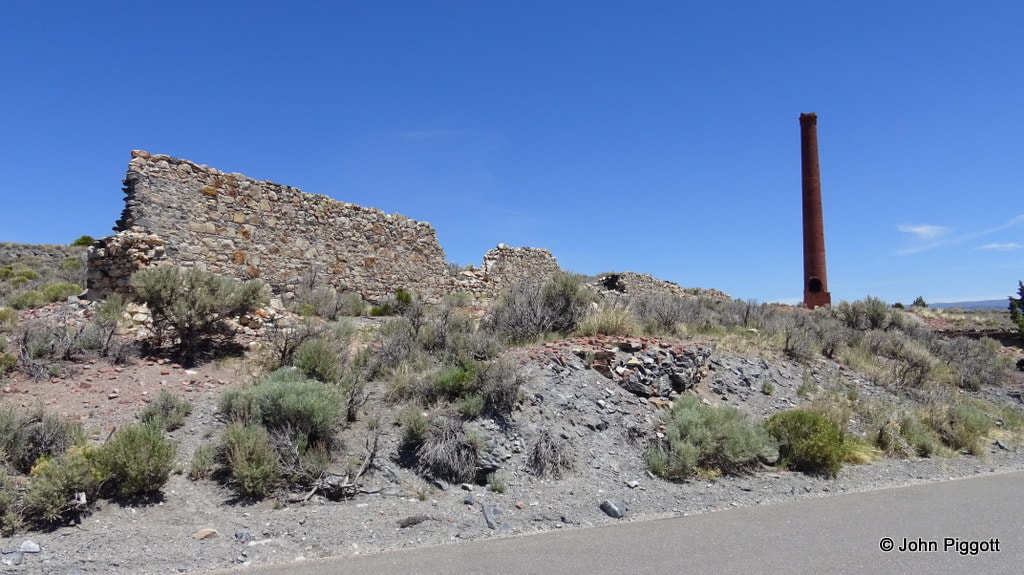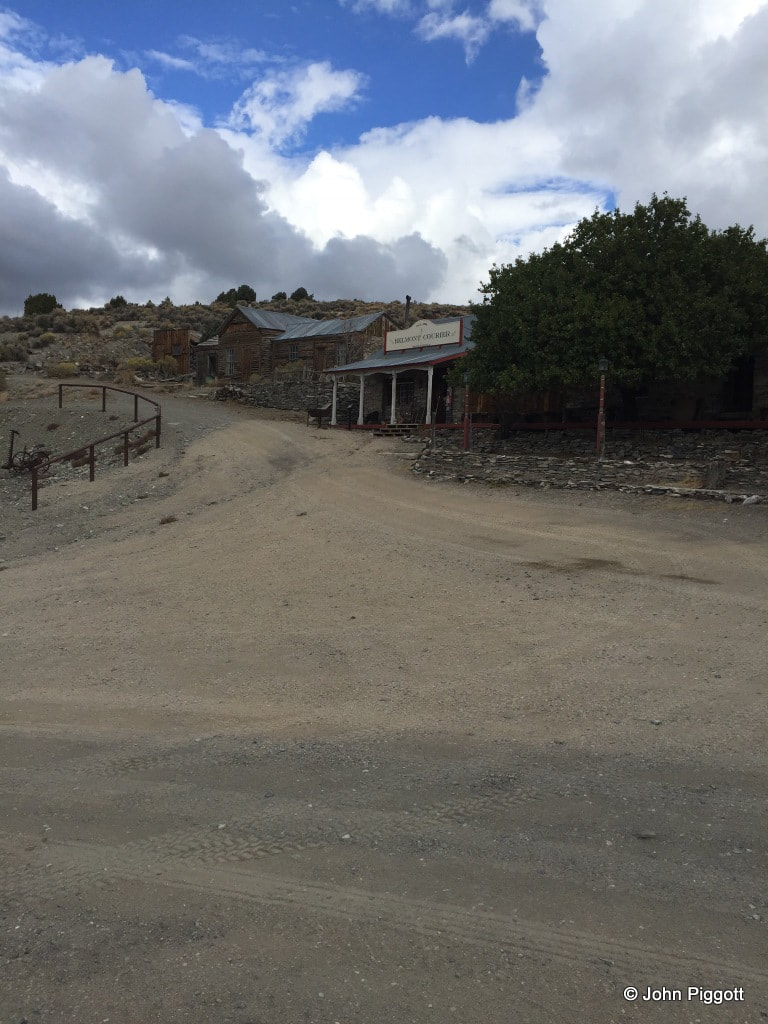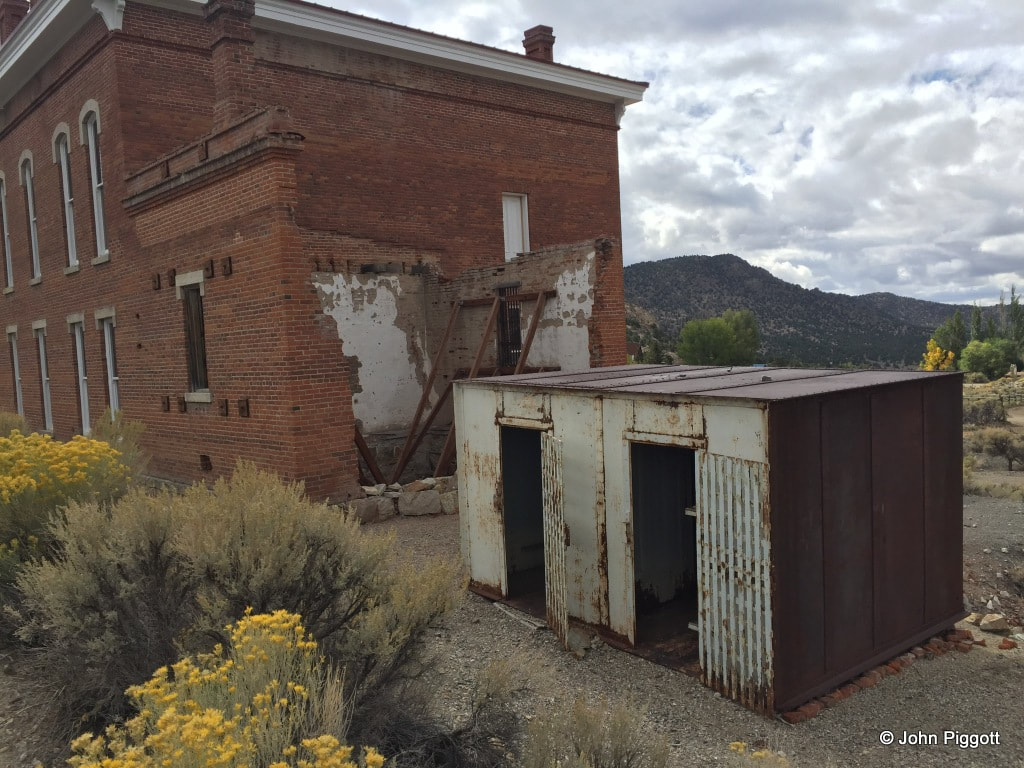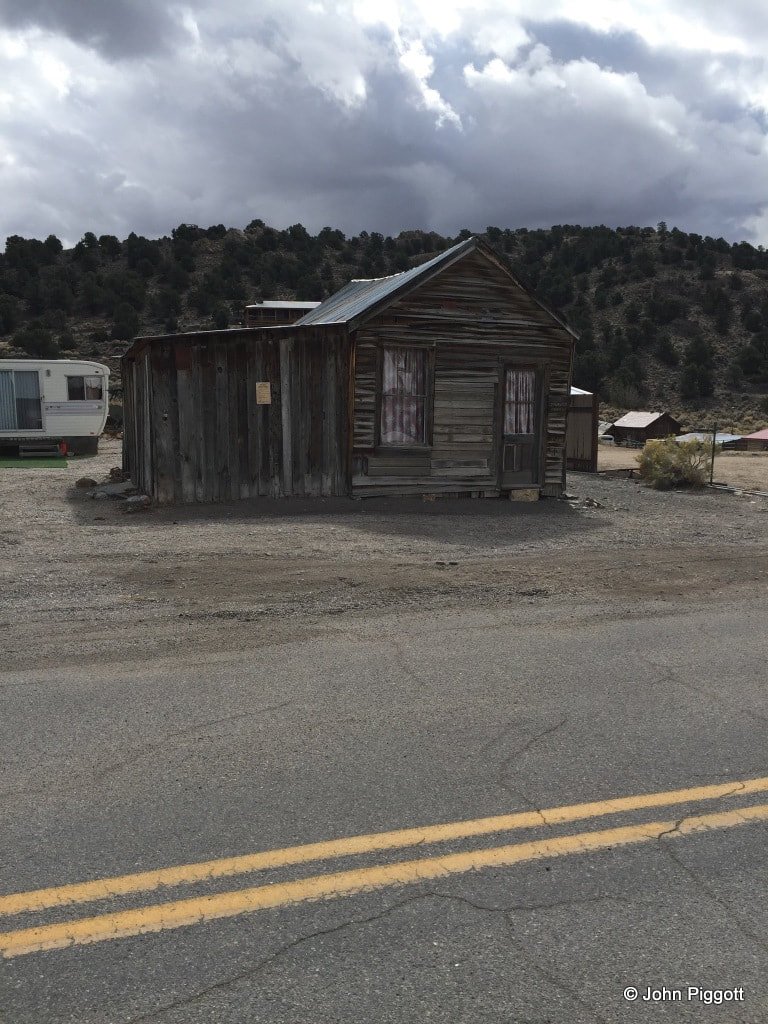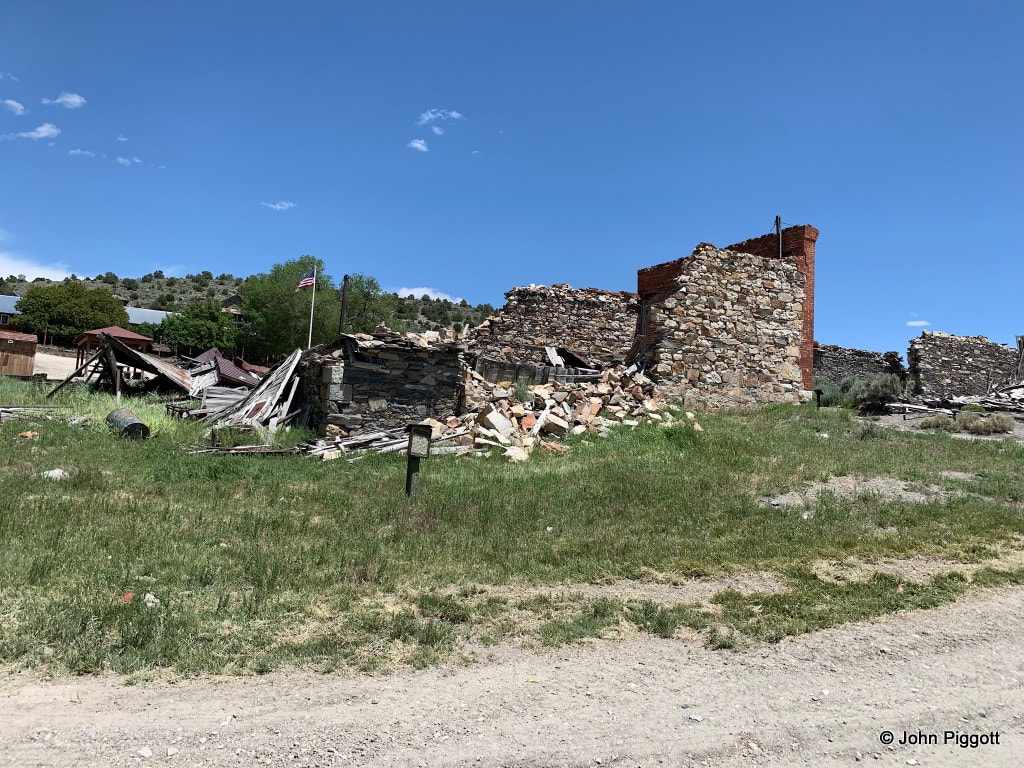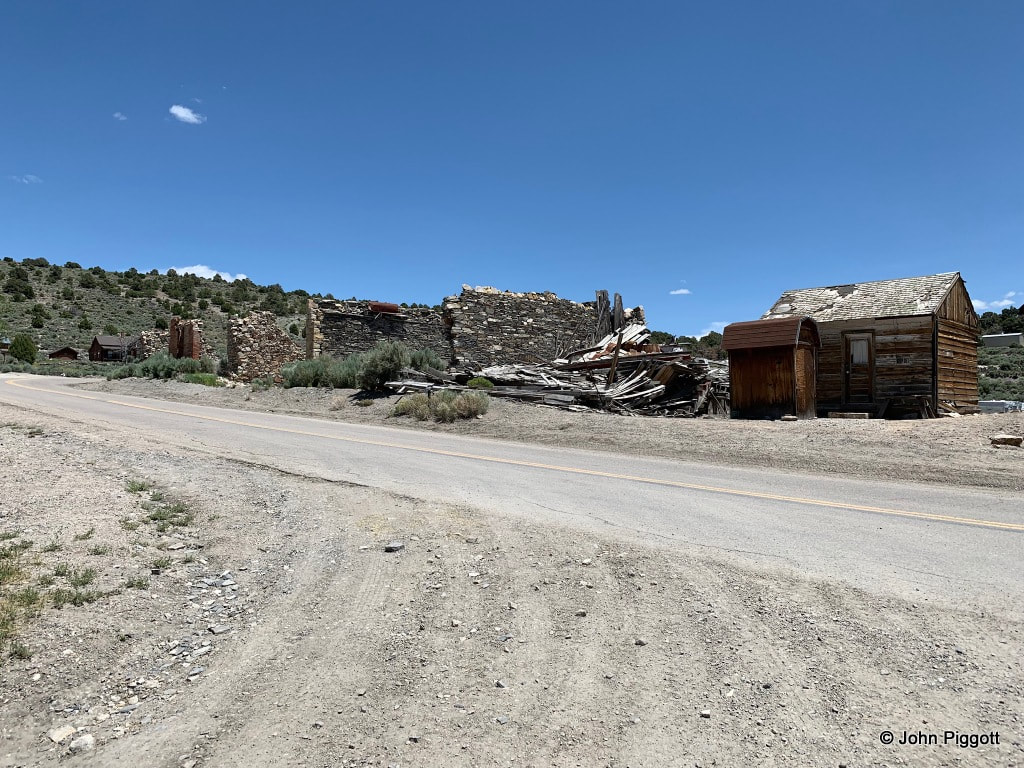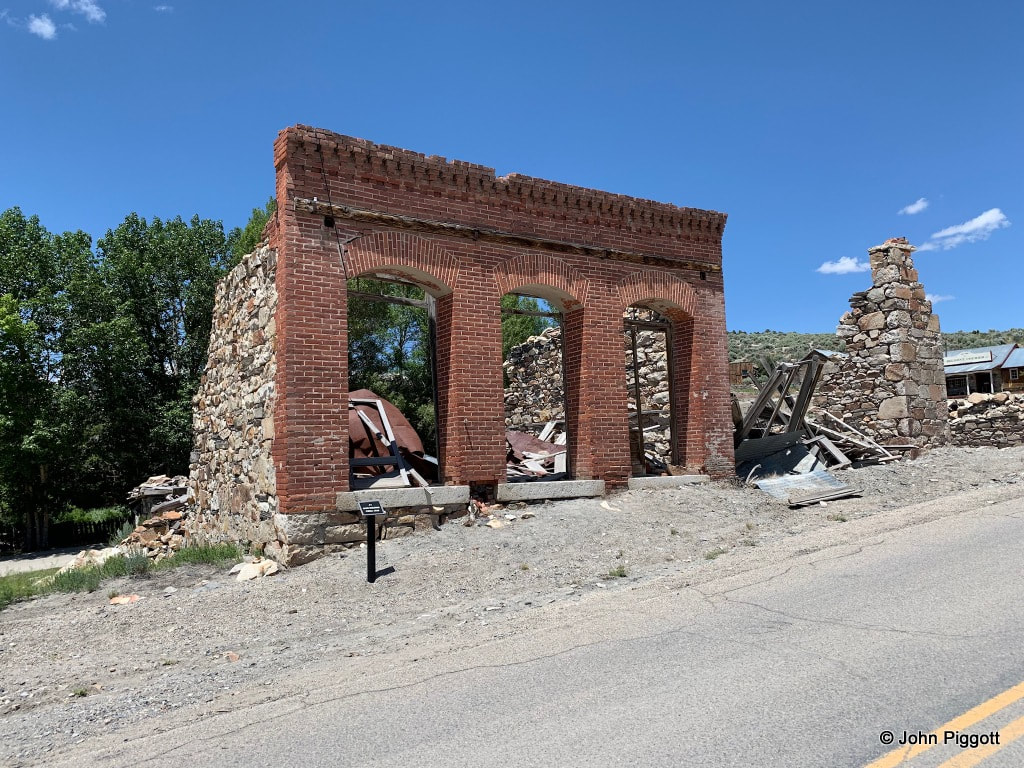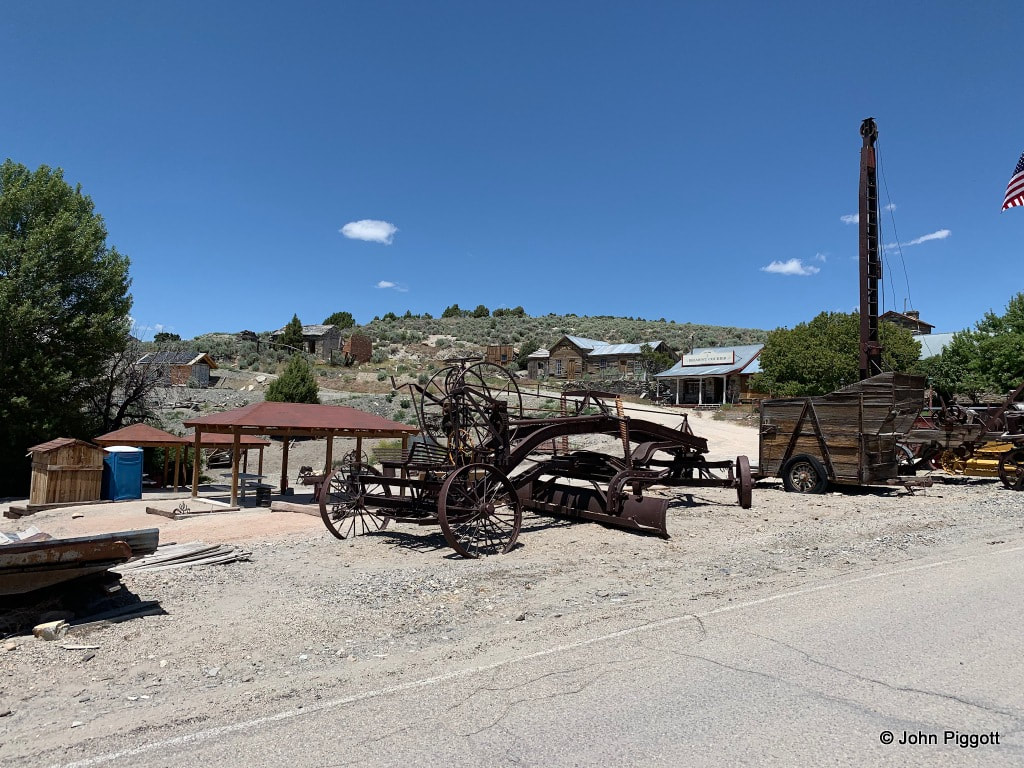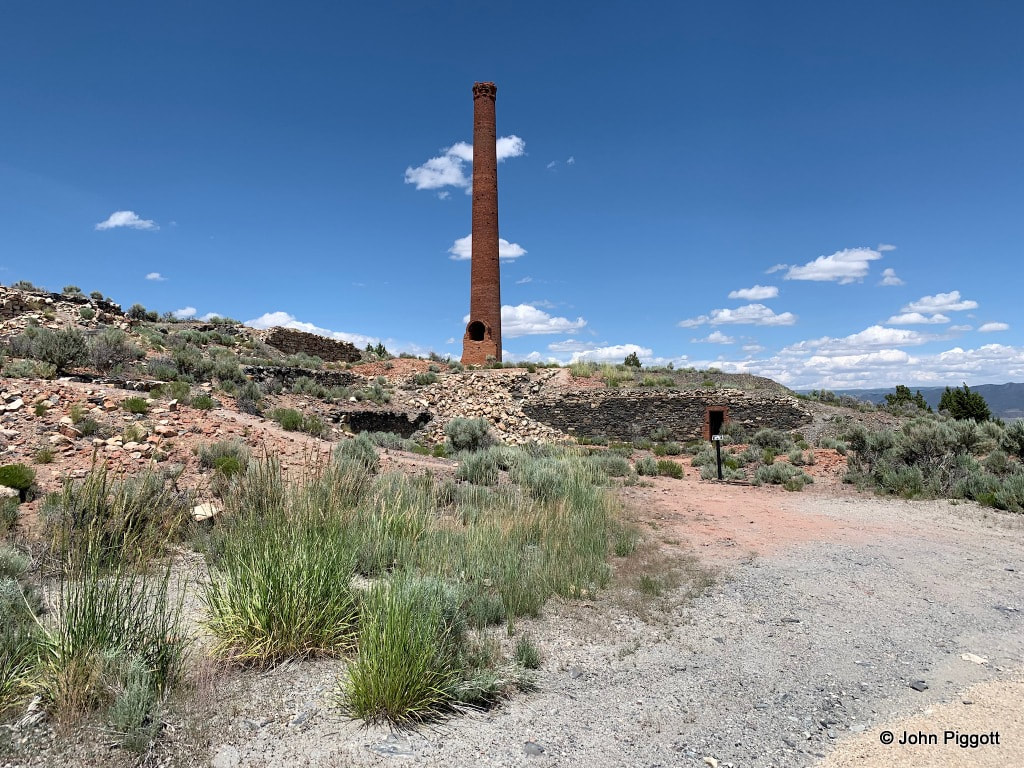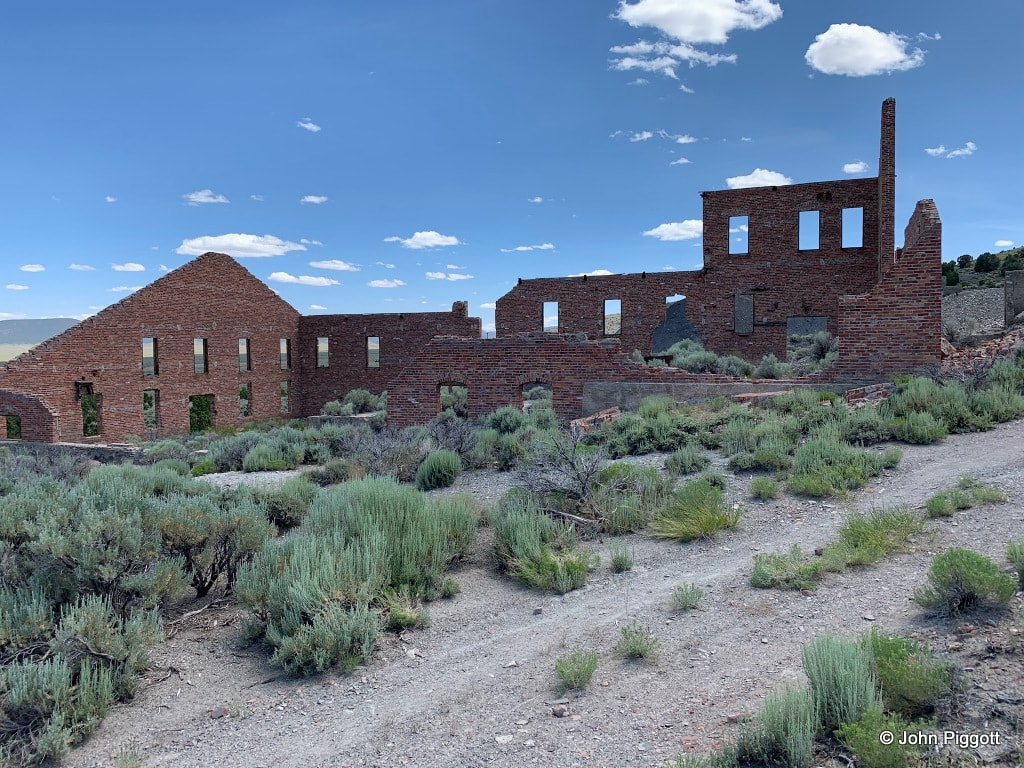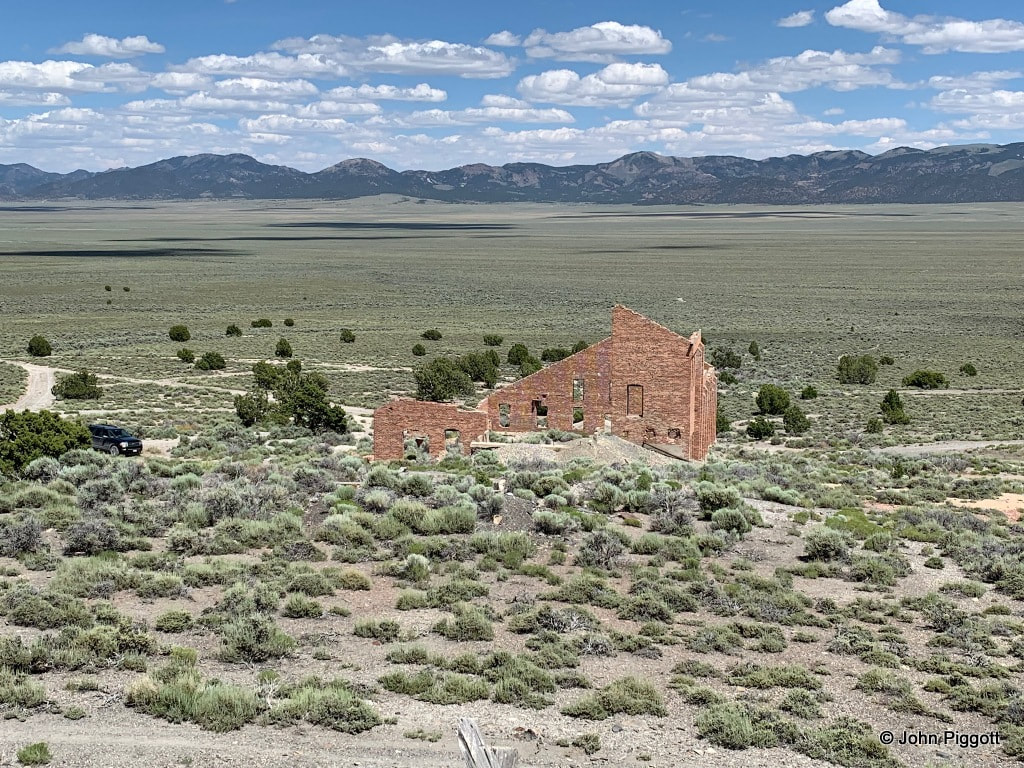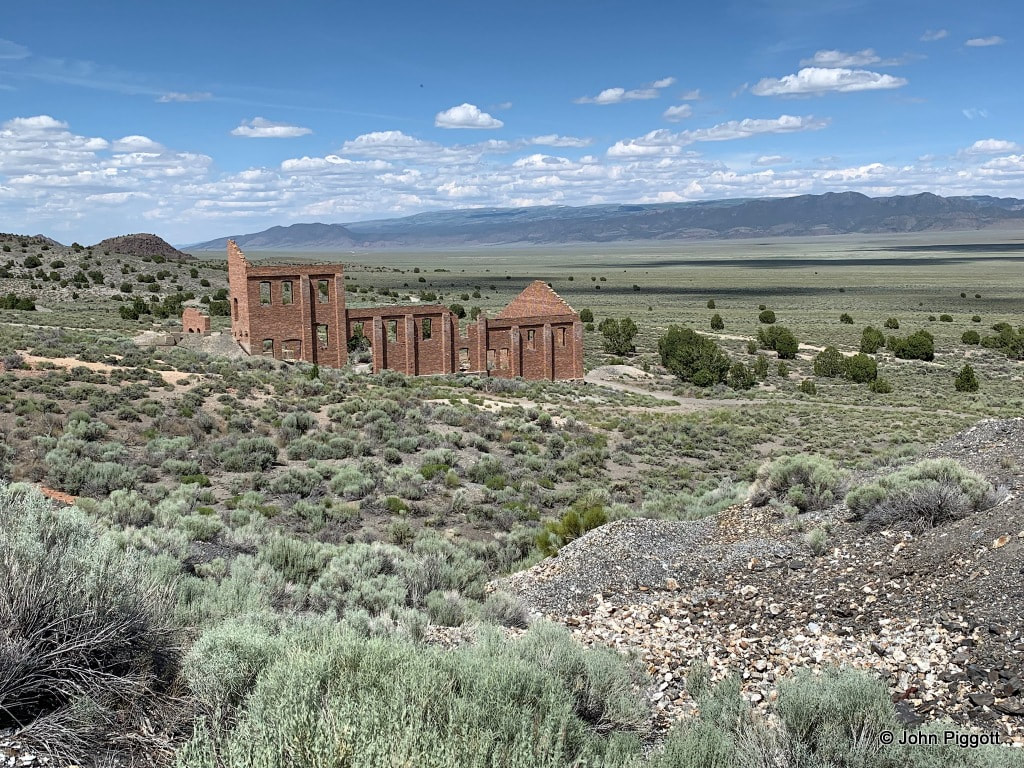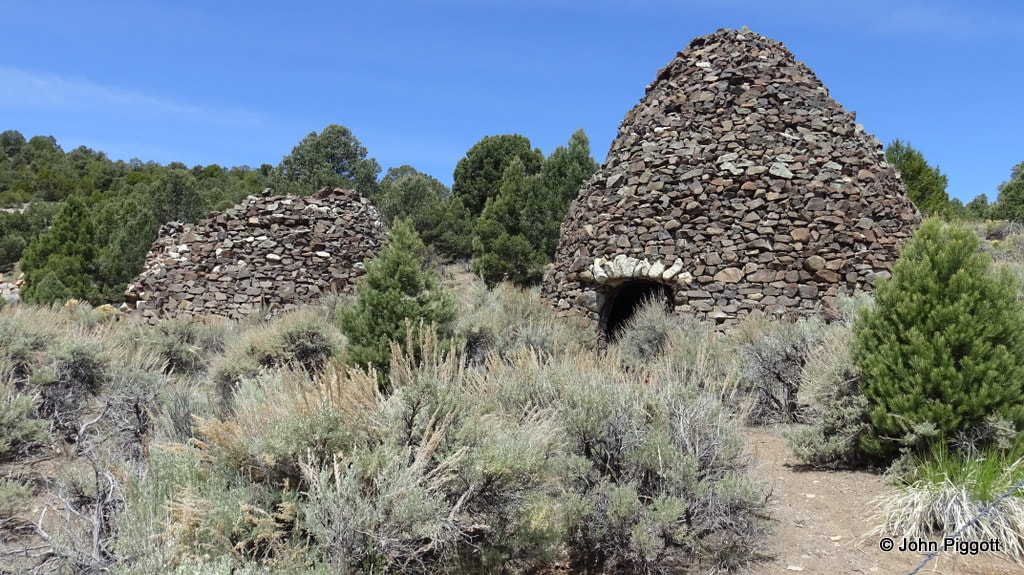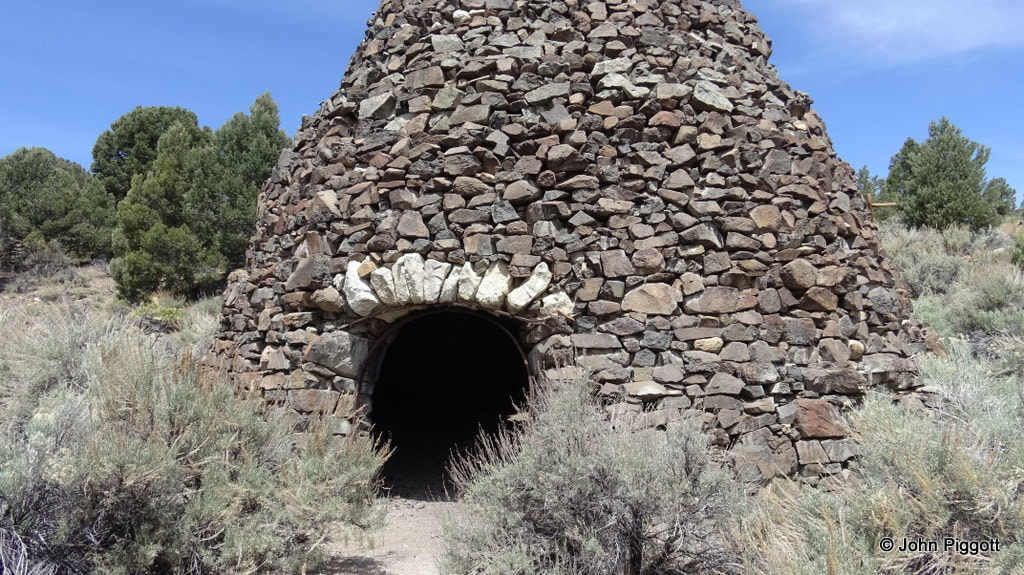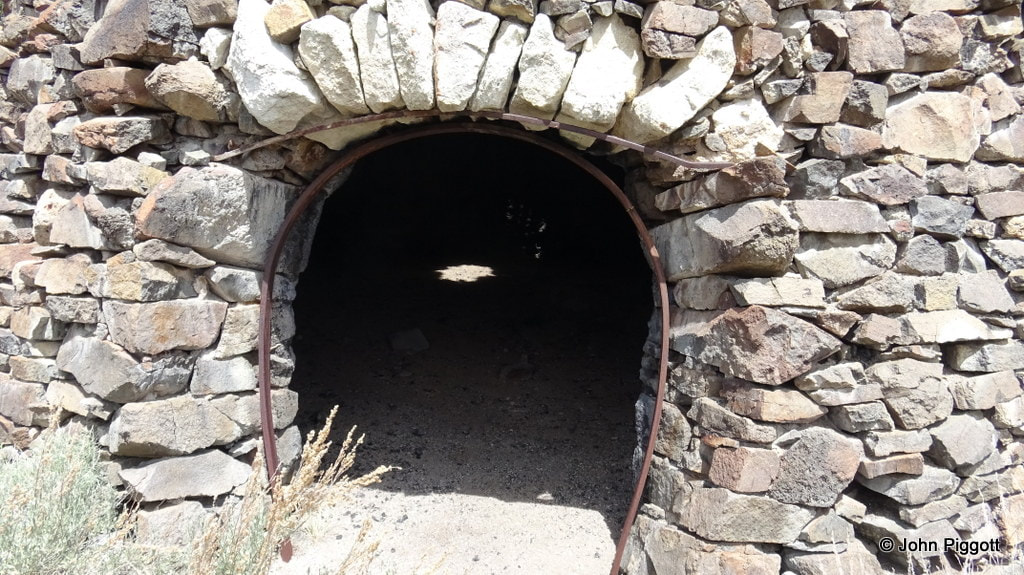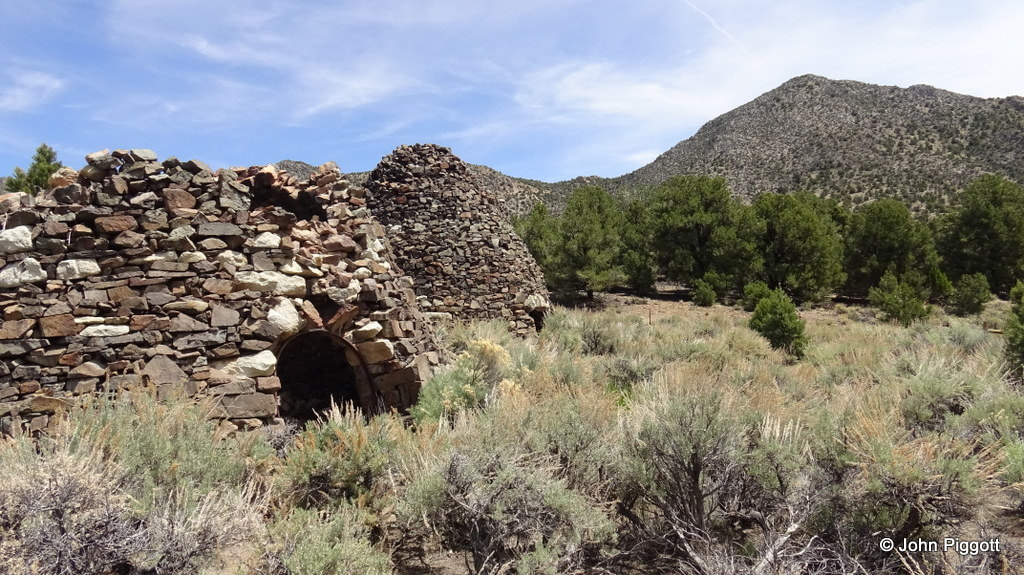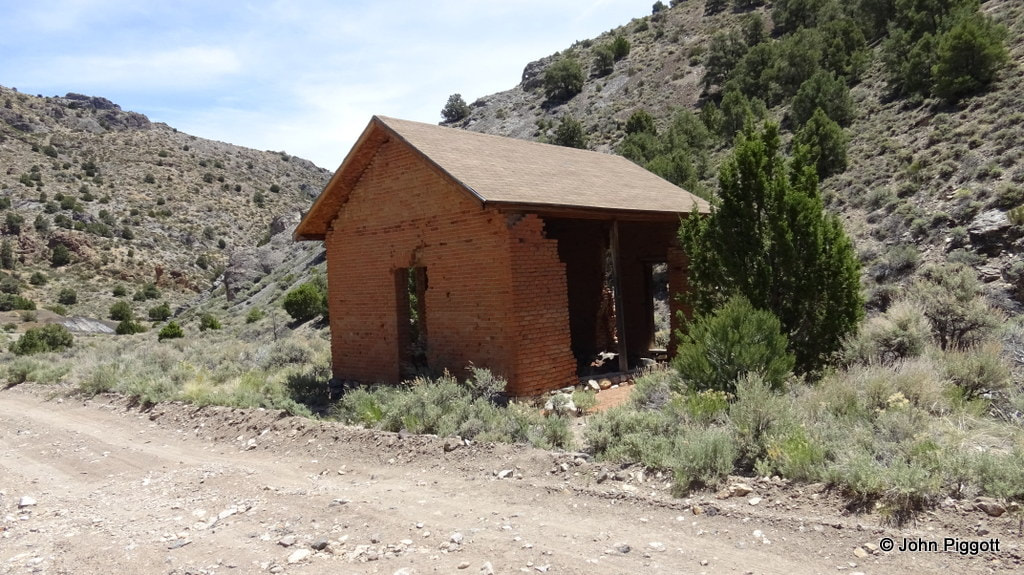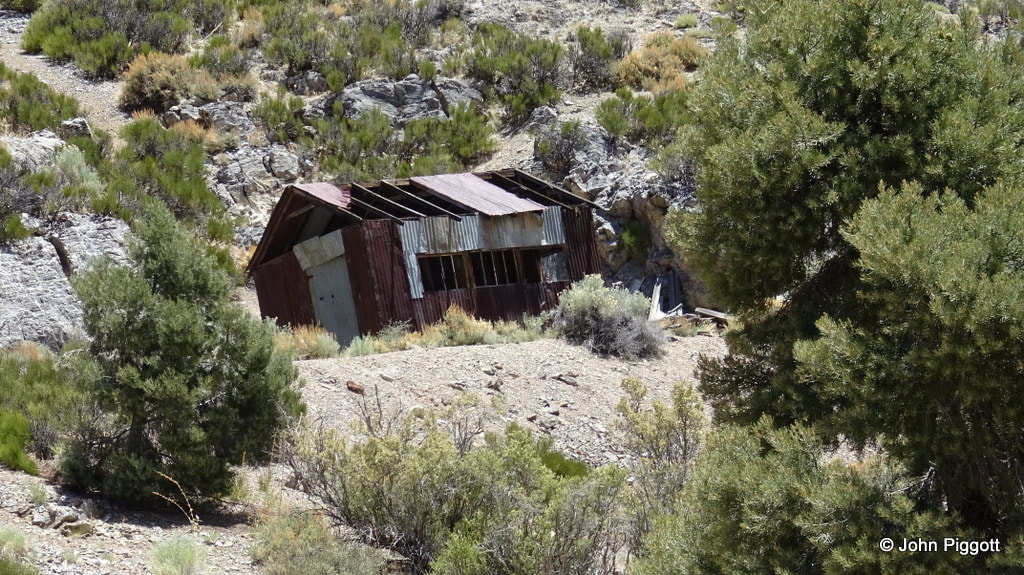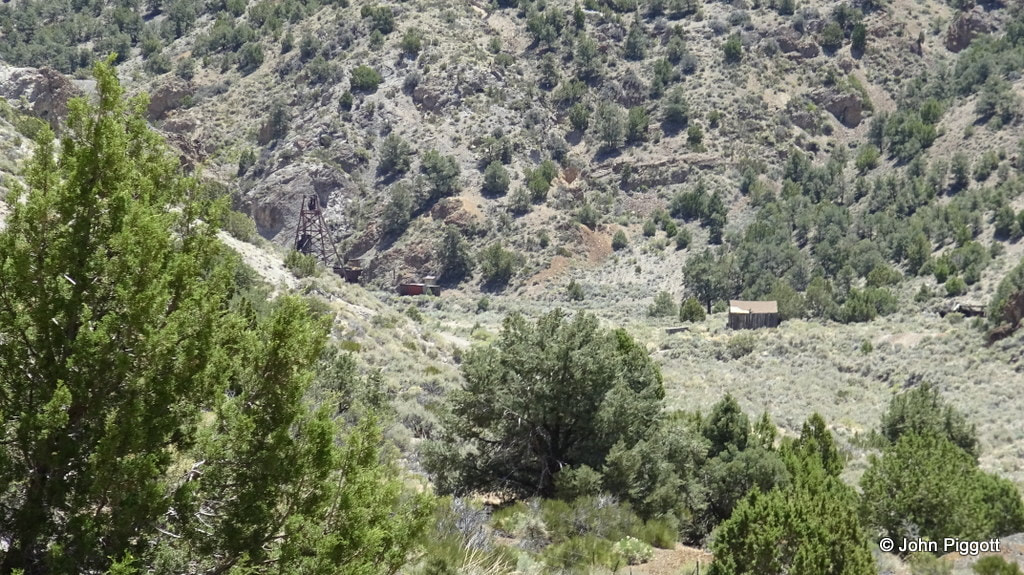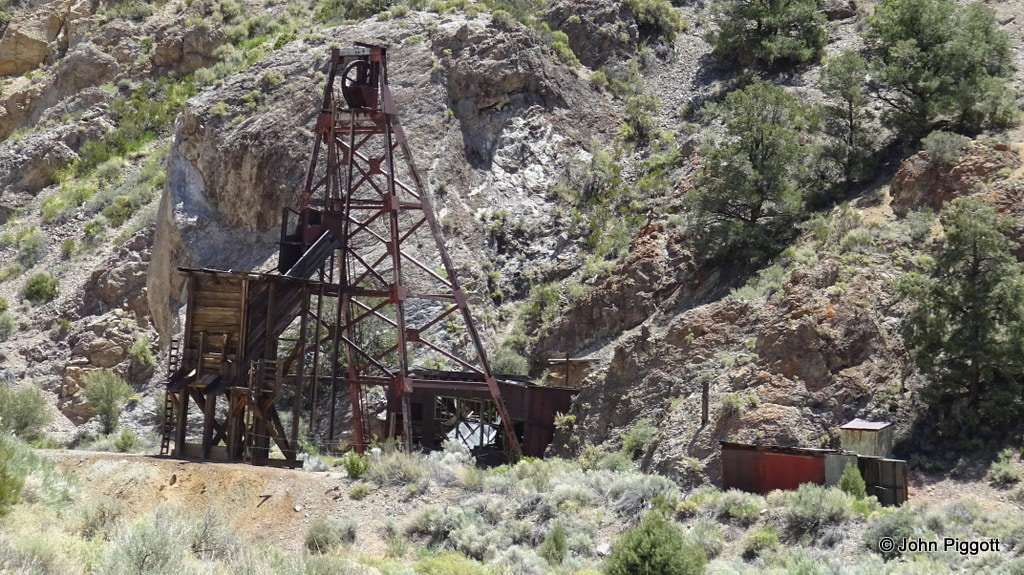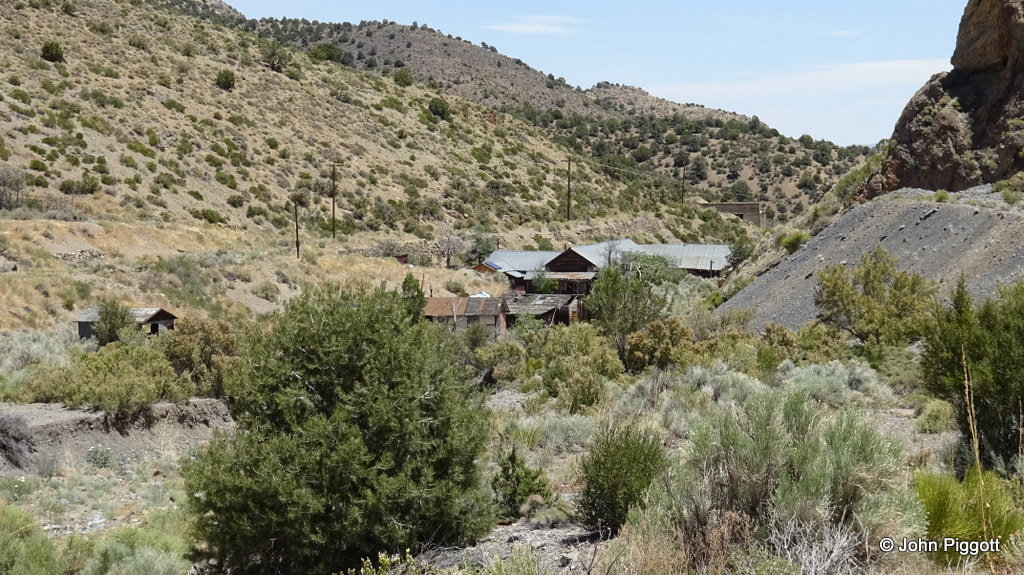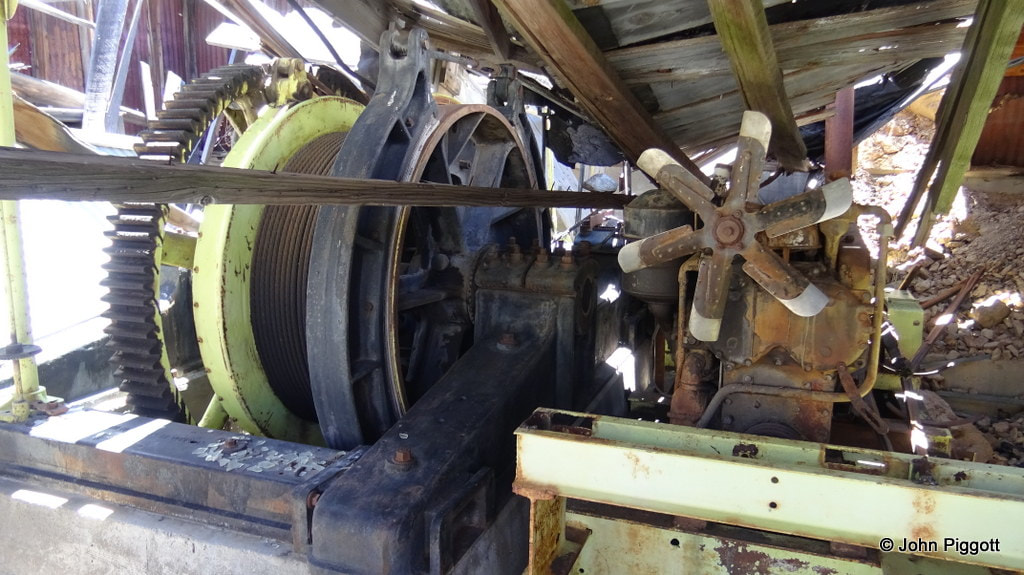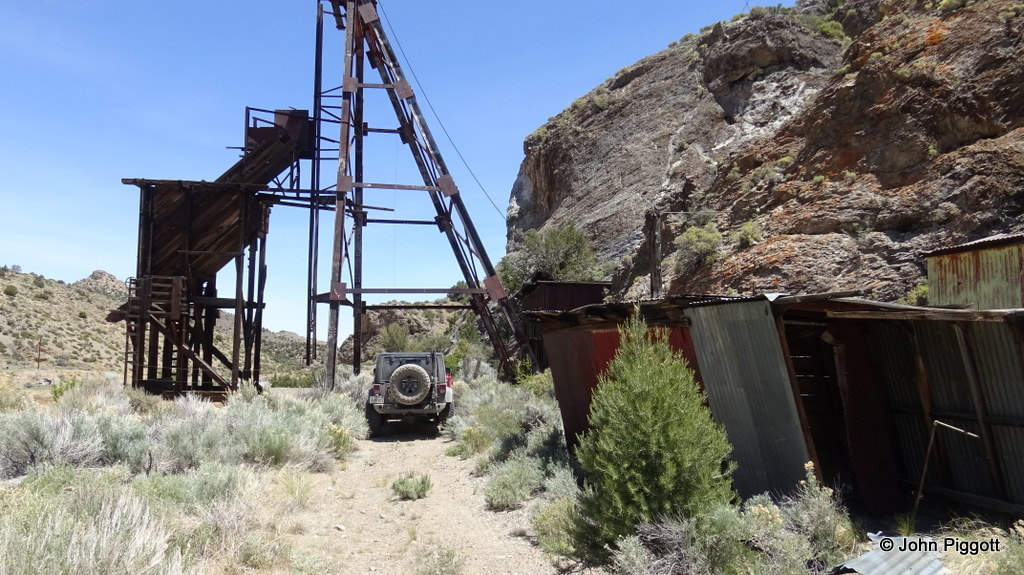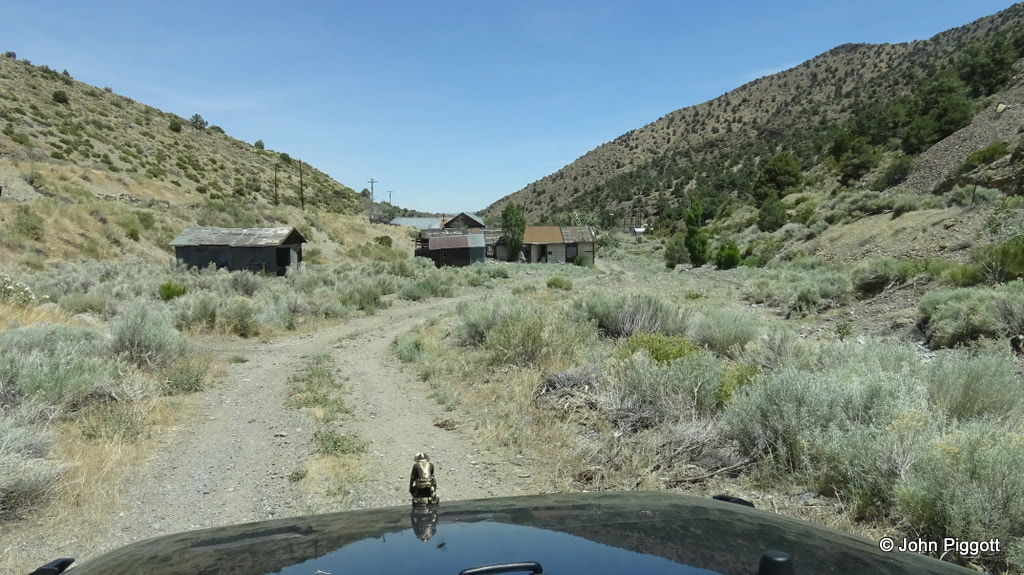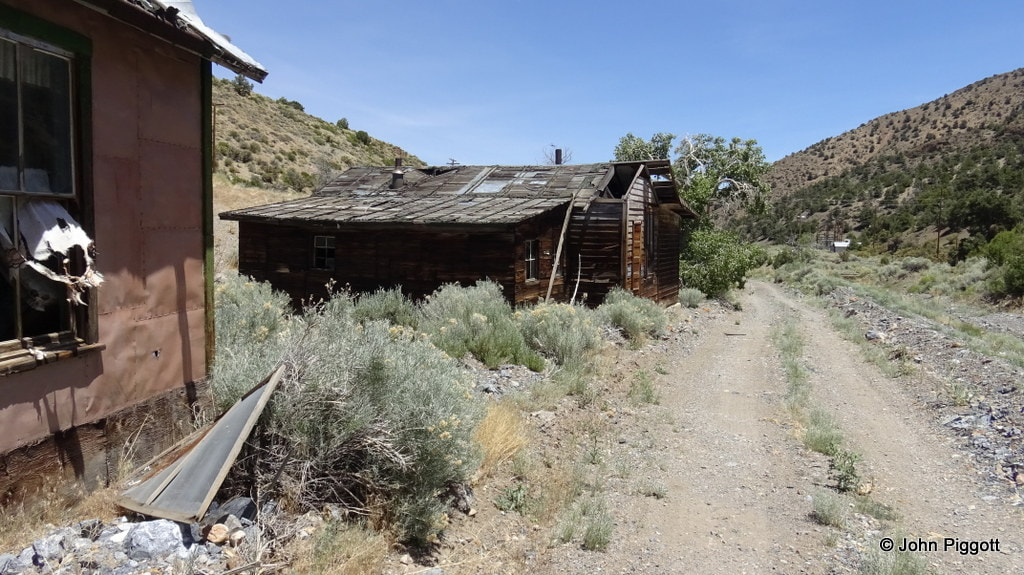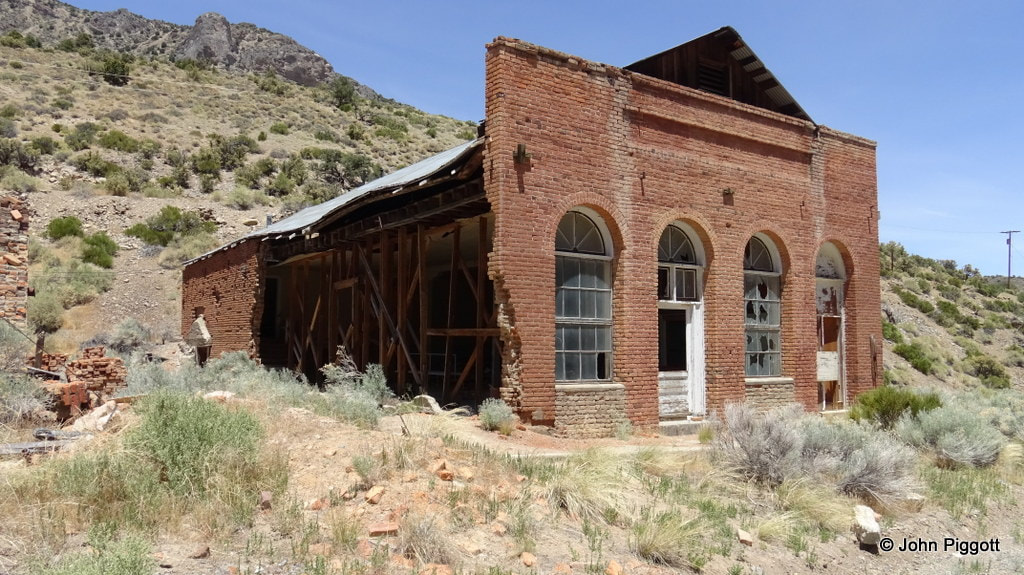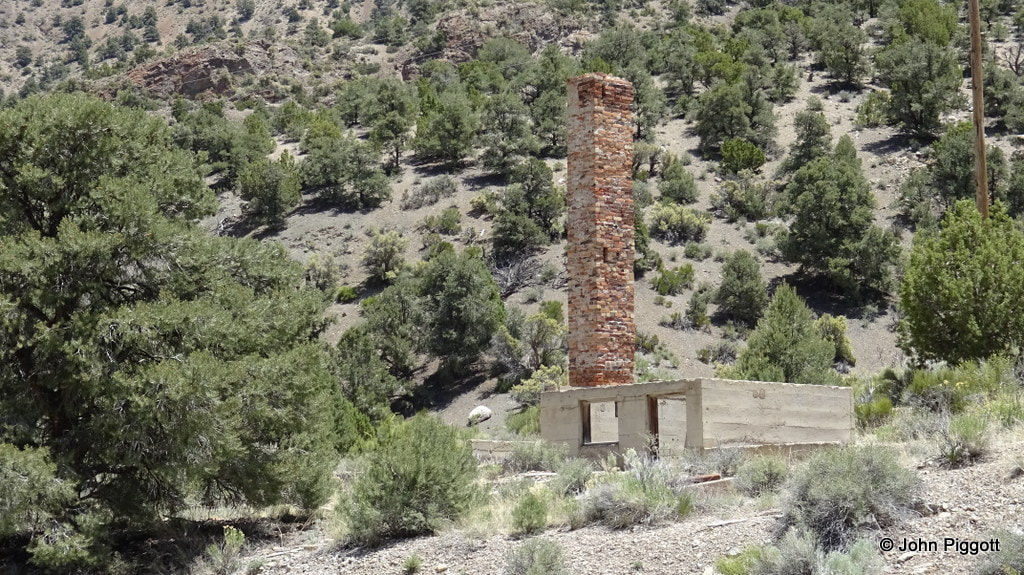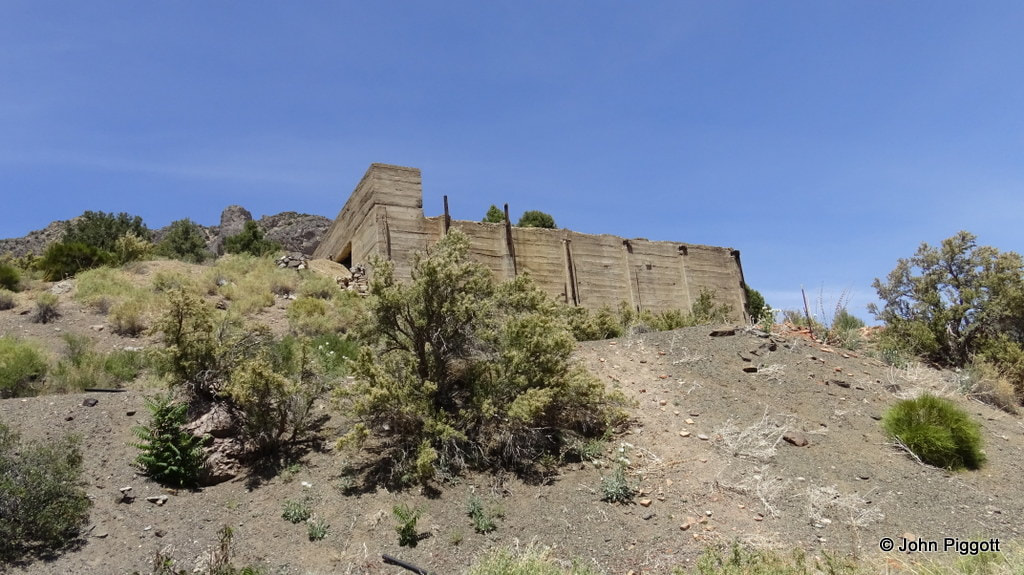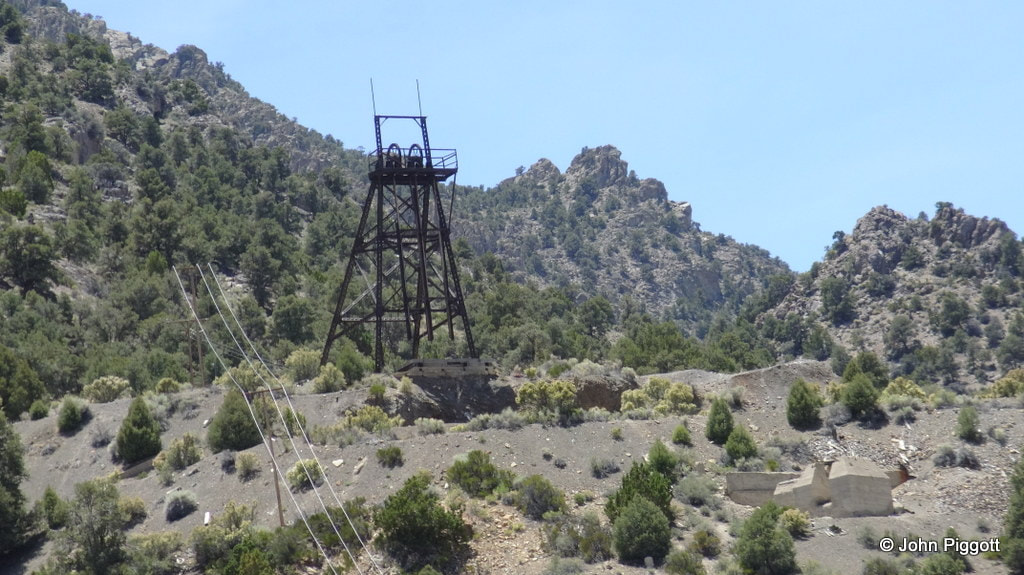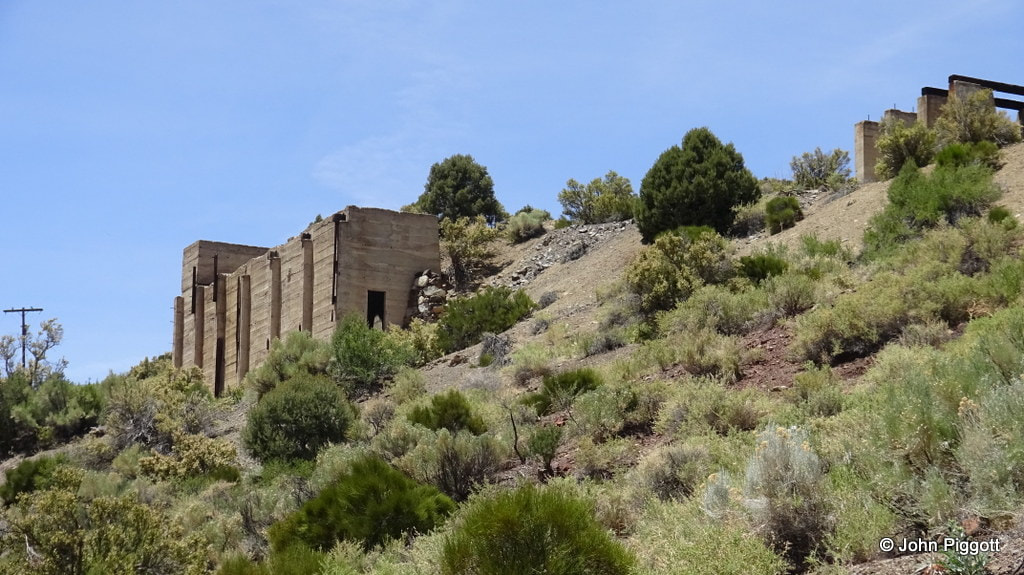Other Nevada Mining and Ghost Towns
|
John Piggott , August 2020 Travelogue
Continued from the dialog begun on Eureka Mines. During our August 2019 outing, we decided to head south from Eureka to explore South Sixmile Canyon to find and photograph charcoal kilns. Unbeknownst to us at the time, we were apparently following the route of the old Belmont-Tybo-Eureka stage coach line, which ran in the 1870s and 1880s connecting the towns of Belmont, Tybo and Eureka. Eureka was, in its day, a focal point for numerous stage lines connecting the railroad in Austin with Belmont, Tybo, and Hamilton and even as far away as Pioche. (see our page Stations for Stage and Freight) Our 2019 route from Eureka passed through Fish Creek (where we viewed the grave of Henry C. Fenstermaker at Fish Creek Ranch see right), then past the Willow Creek Ranch, continuing south to the site of Summit Station (nothing remains of Summit Station), then further south to Pritchard’s Station (a beautiful old stone building), and finally to Moores Station (another beautiful old stone building), where we basically ended the trip. So, after some reading and a little research, this year we decided to try to complete the stage route, but this time starting from the other end at Belmont and completing the leg to Moores Station. We based out of Tonopah and, again in August, decided to follow what we thought would be the most likely stage coach route starting from Belmont, Nevada. |
Henry Clay Fenstermaker Sr. tombstone
BIRTH 10 Jan 1839 Pennsylvania, USA DEATH 10 Jan 1891 (aged 52) Eureka County, Nevada, USA Burial at Fish Creek Ranch, Eureka, Nevada The original owner of Fish Creek Ranch. Fish Creek Ranch is located approx. 20 miles southeast of Eureka, Nevada |
Belmont
Belmont is a neat little town; part old ghost town and part new residences. The town is clean and well kept. The current residents are obviously proud of their town and keep it in good condition, all the while the original building are in a state of arrested decay.
"After about 20 years of life, Belmont died. But while it lived, it enjoyed life to the fullest. Born about 1865, Belmont produced $15 million of silver and lead ore before its demise. Following a silver strike in 1865, other minerals were soon after discovered, including copper lead and antimony. As the boom continued to flourish, it attracted many gold hungry prospectors, including a few notable people like Tasker Oddie, the 12th governor of Nevada and a United States Senator. It also was the seat of Nye County. Picking up momentum in the 1870s, the town reached its largest population at 2,000. Thanks to plentiful silver in the surrounding hills, Belmont once boasted a population of 15,000; hence a whole lot of seriously amazing ruins, including a bank, miner’s cabins, the storied Belmont Courthouse, abandoned mine shafts, 100-foot-tall brick chimneys, and the picture-perfect combination stamp mill ruins. Already having become the county seat, the town boasted four stores, two saloons, five restaurants, livery stable, a post office, an assay office, a bank, school, telegraph office, two newspapers, and a blacksmith shop. The population boom was short-lived however, and by 1887 several of the mines shut down.
During this era timber was in such high demand that when the settlers relocated to the next hot spot they took what was most valued: the wood infrastructure of their homes. Having your own timber in tow made life much easier at your next camp. When the town was nearly abandoned, most of the roofs went with them, but the Belmont’s pride and joy still remains: The Belmont Courthouse. This building in particular kept its original roof intact until just a few years ago when it was fully renovated."
There is plenty to see in Belmont. The town is full of historic ruins and artifacts; Belmont stands as one of the best ghost towns anyone could visit.
From Belmont we headed east through Hunts Canyon and McCann Canyon, across Stone Cabin Valley to Kiln Canyon. After finding and photographing several kilns, and because it was late in the day, we headed back to Tonopah for the night.
"After about 20 years of life, Belmont died. But while it lived, it enjoyed life to the fullest. Born about 1865, Belmont produced $15 million of silver and lead ore before its demise. Following a silver strike in 1865, other minerals were soon after discovered, including copper lead and antimony. As the boom continued to flourish, it attracted many gold hungry prospectors, including a few notable people like Tasker Oddie, the 12th governor of Nevada and a United States Senator. It also was the seat of Nye County. Picking up momentum in the 1870s, the town reached its largest population at 2,000. Thanks to plentiful silver in the surrounding hills, Belmont once boasted a population of 15,000; hence a whole lot of seriously amazing ruins, including a bank, miner’s cabins, the storied Belmont Courthouse, abandoned mine shafts, 100-foot-tall brick chimneys, and the picture-perfect combination stamp mill ruins. Already having become the county seat, the town boasted four stores, two saloons, five restaurants, livery stable, a post office, an assay office, a bank, school, telegraph office, two newspapers, and a blacksmith shop. The population boom was short-lived however, and by 1887 several of the mines shut down.
During this era timber was in such high demand that when the settlers relocated to the next hot spot they took what was most valued: the wood infrastructure of their homes. Having your own timber in tow made life much easier at your next camp. When the town was nearly abandoned, most of the roofs went with them, but the Belmont’s pride and joy still remains: The Belmont Courthouse. This building in particular kept its original roof intact until just a few years ago when it was fully renovated."
There is plenty to see in Belmont. The town is full of historic ruins and artifacts; Belmont stands as one of the best ghost towns anyone could visit.
From Belmont we headed east through Hunts Canyon and McCann Canyon, across Stone Cabin Valley to Kiln Canyon. After finding and photographing several kilns, and because it was late in the day, we headed back to Tonopah for the night.
Tybo
The next day we went straight to Tybo, and what a place it is. It appeared there is still one family living there but the old ghost town is mostly gone. Plenty of things to see in Tybo and still a lot of relics and ruins left from its heyday. A few of the original buildings are still partially standing. The brick remains of the Trowbridge Store, once one of the busiest businesses in the former mining camp still stands very prominently along the main street.
"Silver was discovered in Tybo Canyon in 1866, although large-scale mining didn’t begin until about six years later with construction of a smelter. The smelter was built in 1872, but it would take several years before the town was officially established in 1874, and by 1876 Tybo had 1,000 residents. It boasted a small commercial district that included five stores, a school, a post office, an express office, the Tybo Sun newspaper, a Wells Fargo office, a bank, several retail businesses, and numerous saloons.
Known as a fairly peaceful camp in its early years, by the mid-1870s it had evolved into three distinctive districts divided by ethnicity (Irish, Cornish and Central European) and had experienced some cultural tensions. Ironically, one of the few occasions during which the three groups were unified was when they banded together to repel Chinese woodcutters who attempted to settle in the area. As in many mining camps of the west, the white settlers did not like the Chinese. Angered by many Chinese who had “invaded” their camp, there was much heated talk which started in the saloons fueled with the help of flowing liquor. Before long, they began to retaliate against the Chinese with words, fists, knives, and guns, leading to a number of nameless graves in the cemetery.
While it’s been largely abandoned for much of the past half-century, this central Nevada mining town of has managed to survive into the 21th century with an impressive number of its historic structures intact."
From Tybo we made the relatively short hop over to Hot Creek. Stations for Stage and Freight
And then from from Hot Creek, as we finally came to Moores Station, we completed our connection to the first half of the stage route which we had unknowingly traced from Eureka a year earlier.
I guess I’ll never know for sure whether we had actually retraced the original route of the Belmont-Tybo-Eureka stage line. But I think it’s safe to say the stage company would probably not have chosen a significantly different route causing it to traverse greater distances and more difficult terrain. In any case, it was a great adventure with lots of fun and interest, and a very good history lesson about frontier Nevada.
"Silver was discovered in Tybo Canyon in 1866, although large-scale mining didn’t begin until about six years later with construction of a smelter. The smelter was built in 1872, but it would take several years before the town was officially established in 1874, and by 1876 Tybo had 1,000 residents. It boasted a small commercial district that included five stores, a school, a post office, an express office, the Tybo Sun newspaper, a Wells Fargo office, a bank, several retail businesses, and numerous saloons.
Known as a fairly peaceful camp in its early years, by the mid-1870s it had evolved into three distinctive districts divided by ethnicity (Irish, Cornish and Central European) and had experienced some cultural tensions. Ironically, one of the few occasions during which the three groups were unified was when they banded together to repel Chinese woodcutters who attempted to settle in the area. As in many mining camps of the west, the white settlers did not like the Chinese. Angered by many Chinese who had “invaded” their camp, there was much heated talk which started in the saloons fueled with the help of flowing liquor. Before long, they began to retaliate against the Chinese with words, fists, knives, and guns, leading to a number of nameless graves in the cemetery.
While it’s been largely abandoned for much of the past half-century, this central Nevada mining town of has managed to survive into the 21th century with an impressive number of its historic structures intact."
From Tybo we made the relatively short hop over to Hot Creek. Stations for Stage and Freight
And then from from Hot Creek, as we finally came to Moores Station, we completed our connection to the first half of the stage route which we had unknowingly traced from Eureka a year earlier.
I guess I’ll never know for sure whether we had actually retraced the original route of the Belmont-Tybo-Eureka stage line. But I think it’s safe to say the stage company would probably not have chosen a significantly different route causing it to traverse greater distances and more difficult terrain. In any case, it was a great adventure with lots of fun and interest, and a very good history lesson about frontier Nevada.
click on photos for larger views
|
Tybo map
|
Belmont map
|
